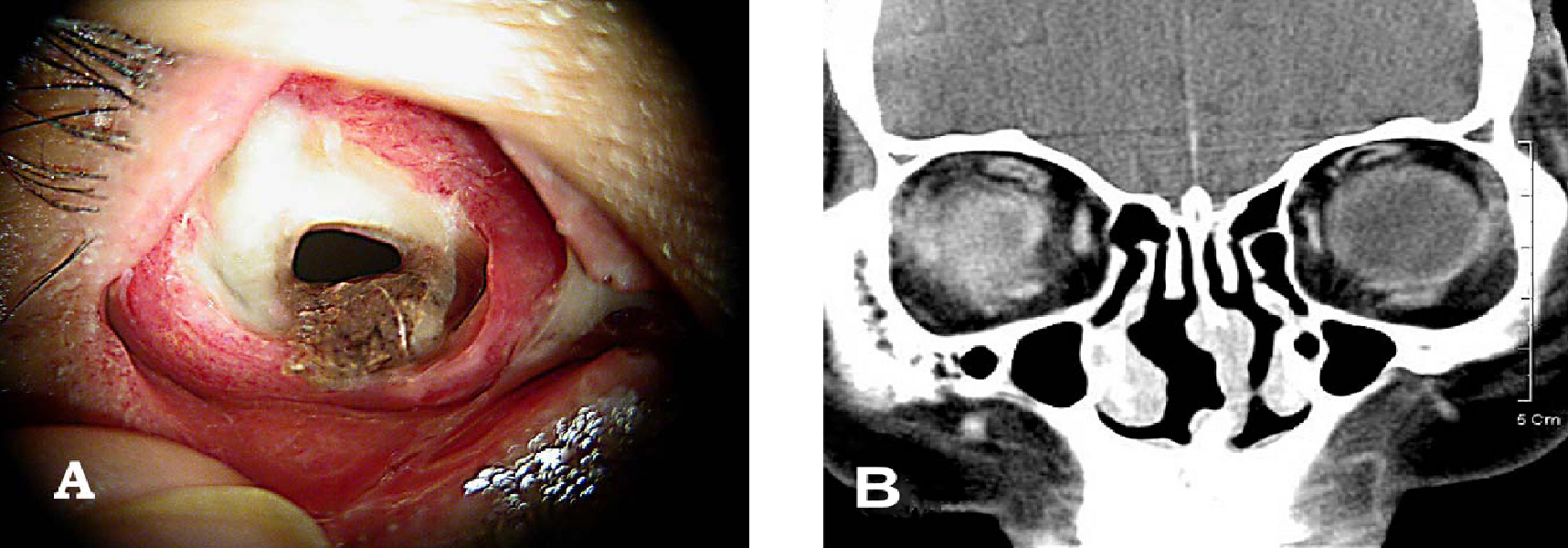Korean J Ophthalmol.
2007 Mar;21(1):45-47. 10.3341/kjo.2007.21.1.45.
Endogenous Aeromonas Hydrophila Endophthalmitis in an Immunocompromised Patient
- Affiliations
-
- 1Department of Ophthalmology, Gachon University Gil Medical Center, Incheon, Korea. eyedawns@gilhospital.com
- 2Department of Gastroenterology, Gachon University Gil Medical Center, Incheon, Korea.
- KMID: 1105030
- DOI: http://doi.org/10.3341/kjo.2007.21.1.45
Abstract
- PURPOSE: To report a case of endogenous endophthalmitis due to Aeromonas hydrophila in a patient with distal common bile duct carcinoma and biliary sepsis. METHODS: A 72-year-old woman with distal common bile duct carcinoma, obstructive jaundice, diabetes mellitus, and hypertension had a 1-day history of blurred vision, redness, and eye discharges in the right eye. An ophthalmic examination showed no light perception vision, increased intraocular pressure, severe corneal edema, severe anterior chamber reaction, exudative membranes on the anterior lens surface, and severe vitreal reaction. There was no ocular history of trauma, infection, or surgery in either eye. RESULTS: Under the impression of endogenous bacterial endophthalmitis, immediate intraocular cultures and intravitreal antibiotic injections were performed, but the anterior chamber reaction, and the ultrasonogram findings were deteriorated. Evisceration was undertakened because of extrusion of the intraocular contents, and Aeromonas hydrophila was isolated by intraocular culture. CONCLUSIONS: Endogenous endophthalmitis due to Aeromonas hydrophila is rare, but has a rapid clinical course and a poor prognosis, despite of prompt diagnosis and management.
MeSH Terms
-
Vitreous Body
Ultrasonography
Treatment Failure
Tomography, X-Ray Computed
Injections
*Immunocompromised Host
Humans
*Gram-Negative Bacterial Infections/drug therapy
Female
Eye Evisceration
Endophthalmitis/diagnosis/*microbiology/pathology
Anti-Bacterial Agents/administration & dosage/therapeutic use
Aged
*Aeromonas hydrophila
Figure
Cited by 2 articles
-
Aeromonas hydrophila Myonecrosis in an Immunocompetent Patient
Mi-Hyang Jung, Kwan-Hyun Lee, Dae-Yeun Hwang, Kwan-Hoon Jo, Sun-Young Han, Seon-A Kim, Sang-Rok Lee
Infect Chemother. 2011;43(2):213-216. doi: 10.3947/ic.2011.43.2.213.Evisceration for Intractable Endogenous Endophthalmitis
Yun-Sung Huh, Hwa-Sun Chung, Jun-Hyuck Son
J Korean Ophthalmol Soc. 2008;49(3):396-400. doi: 10.3341/jkos.2008.49.3.396.
Reference
-
1. Frieling JS, Rosenberg R, Edelstein M, et al. Endogenous Aeromonas hydrophila endophthalmitis. Ann Ophthalmol. 1989. 21:117–118.2. Tamura T, Hida T. A case of endogenous Aeromonas hydrophila endophthalmitis. Nippon Ganka Gakkai Zasshi. 2003. 107:535–537.3. Jackson TL, Eykyn SJ, Graham EM, Stanford MS. Endogenous bacterial endophthalmitis: a 17-year prospective series and review of 267 reported cases. Surv Ophthalmol. 2003. 48:403–423.4. Cohen KL, Holyk PR, McCarthy LR, Peiffer RL. Aeromonas hydrophila and Plesiomonas shigelloides endophthalmitis. Am J Ophthalmol. 1983. 96:403–404.5. Feaster FT, Nisbet R, Barber JC. Aeromonas hydrophila corneal ulcer. Am J Ophthalmol. 1978. 85:114–117.6. Carta F, Pinna A, Zanetti S, et al. Corneal ulcer caused by Aeromonas species. Am J Ophthalmol. 1994. 118:530–531.
- Full Text Links
- Actions
-
Cited
- CITED
-
- Close
- Share
- Similar articles
-
- Aeromonas hydrophila Myonecrosis in an Immunocompetent Patient
- Aeromonas hydrophila and Aspiration Pneumonia: A Diverse Presentation
- A Case of Peritoneal Dialysis-related Peritonitis Caused by Aeromonas Hydrophila in the Patient Receiving Automated Peritoneal Dialysis
- Production of extracellular enzymes and histamine release from rat peritoneal mast cells by aeromonas hydrophila
- A Case of Aeromonas hydrophila Necrotizing fasciitis in Patient on Hemodialysis




